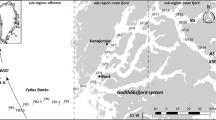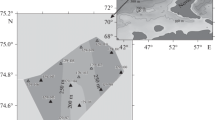Abstract
Plankton community structure was analysed during spring at four stations along a transect from the polar ice into open waters of the Barents Sea. The transect mimicks a time span of months in the biological succession during the Arctic summer. The significance of the microbial food web vs the more classical food web was evaluated using carbon budget models. The standing stocks of diatom-dominated phytoplankton and bacteria were generally high especially in connection to ice. The biomass of microzooplankton, dominated by heterotrophic dinoflagellates was significantly high, with specific growth rates following the in situ temperature. The mean ± SE specific growth rate was 0.40±0.12 d−1 for ciliates and 0.24 ± 0.05 d−1 for heterotrophic dinoflagellates, indicating no food limitation. The estimated total carbon requirement for microzooplankton was, at the ice-covered station, approximately 100% of the daily primary production, decreasing to 25% in the open water. Carbon-specific secondary production of the copepodsCalanus finmarchicus (Gunnerus),C. glacialis (Jaschnov),C. hyperboreus (Krøyer) andMetridia longa (Lubbock) were analysed by egg production.C. finmarchicus andM. longa were productive at all stations, including the ice-covered locations, with a maximum at 0.08 d−1 and 0.035 d−1, respectively. The other, more Arctic-related,Calanus spp. were virtually outspawned. The standing stock of copepods was only 10–20% of the total microbial grazer biomass. The community growth and grazing by copepods showed significantly less quantitative importance for the pelagic carbon flow than the microbial processes.
Similar content being viewed by others
References
Andersen P (1988) The quantitative importance of the “Microbial Loop” in the marine pelagic: a case study from the North Bering/Chukchi Sea. Arch Hydrobiol 31:243–251
Barthel KG (1988) Feeding of threeCalanus species on different phytoplankton assemblages in the Greenland Sea. Meeresforch 32:92–106
Barthel KG (1990) Relationships of food uptake and body components ofCalanus finmarchicus, C. glacialis andC. hyperboreus to particulate matter and water characteristics in Fram Strait. Polar Biol 10:343–350
Berggreen U, Hansen B, Kiørboe T (1988) Food size spectra, ingestion and growth of the copepodAcartia tonsa during development: implications for determination of copepod production. Mar Biol 99:341–355
Billen G, Bequevort S (1991) Phytoplankton-bacteria relationships in the Antarctic marine ecosystem. Polar Res 10:245–253
Bjørnsen PK, Riemann B, Horsted SJ, Nielsen TG, Pocksten J (1988) Trophic interactions between heterotrophic nanoflagellates and bacterioplankton in manipulated seawater enclosures. Limnol Oceanogr 33:409–420
Bratbak G, Dundas J (1984) Bacterial dry matter content and biomass estimations. Appl Environ Microbiol 48:755–757
Brodsky KA (1959) On phylogenetic relationships of some species ofCalanus (Copepoda) of the northern hemispheres. Zool Zh 38:1537–1553
Båmstedt U, Tande KS (1988) Physiological response ofCalanus finmarchicus andMetridia longa (Copepoda: Calanoida) during the winter-spring transition. Mar Biol 99:31–38
Båmstedt U, Eilertsen HC, Tande KS, Slagstad D, Skjoldal HR (1991) Copepod grazing and its potential impact on the phytoplankton development in the Barents Sea. Polar Res 10:339–353
Carlotti F, Krause M, Radach G (1993) Growth and development ofCalanus finmarchicus related to the influence of temperature: experimental results and conceptual model. Limnol Oceanogr 38:1125–1134
Cole JJ, Findlay S, Pace ML (1988) Bacterial production in fresh and saltwater ecosystems: a cross-system overview. Mar Ecol Prog Ser 43:1–10
Conover RJ, Corner EDS (1968) Respiration and nitrogen excretion by some marine zooplankton in relation to their life cycles. J Mar Biol Assoc UK 48:49–75
Diel S, Tande KS (1992) Does the spawning ofCalanus finmarchicus in high latitudes follow a reproducible pattern? Mar Biol 113:21–31
Eilertsen HC, Tande KS, Taasen JP (1989) Vertical distribution of primary production and grazing byCalanus glacialis Jashnov andC. hyperboreus in arctic waters (Barents Sea). Polar Biol 9:253–260
Fenchel T (1982) Ecology of heterotrophic microflagellates. IV. Quantitative occurrence and importance as bacterial consumers. Mar Ecol Prog Ser 9:35–42
Fenchel T (1986) Protozoan filter feeding. Prog Protistol 1:63–113
Fenchel T (1987) Ecology of protozoa — the functional biology of free living phagotrophic protists. Springer, Berlin Heidelberg New York
Fessenden L, Cowles TJ (1994) Copepod predation on phagotrophic ciliates in Oregon coastal waters. Mar Ecol Prog Ser 107:103–111
Gran HH (1902) Das plankton des norwegischen Nordmeeres, von biologischen und hydrographischen Gesichtspunkten behandelt. Rep Norw Fish Invest 2:1–222
Hansen B, Berggreen UC, Tande KS, Eilertsen HC (1990) Postbloom grazing byCalanus glacialis, C. finmarchicus andC. hyperboreus in the region of the Polar Front, Barents Sea. Mar Biol 104:5–14
Hansen B, Verity P, Falkenhaug T, Tande KS, Norbin F (1994) On the trophic fate ofPhaeocystis pouchetii (Harriot). V. Trophic relationships betweenPhaeocystis and zooplankton: an assessment of methods and size dependence. J Plankton Res 16:487–511
Hansen PJ (1992) Prey size selection, feeding rates and growth dynamics of heterotrophic dinoflagellates with special emphasis onGyrodinium spirale. Mar Biol 114:327–334
Haq SM (1967) Nutritional physiology ofMetridia lucens andM. longa from the Gulf of Maine. Limnol Oceanogr 12:40–51
Hirche H-J (1989) Egg production of the Arctic copepodCalanus glacialis — laboratory experiments. Mar Biol 103:311–318
Hirche H-J (1990) Egg production ofCalanus finmarchicus at low temperature. Mar Biol 106:53–58
Hirche H-J (1991) Distribution of dominant calanoid copepod species in the Greenland Sea during late fall. Polar Biol 11:351–362
Hirche H-J, Bohrer RN (1987) Reproduction of the Arctic copepodCalanus glacialis in Fram Strait. Mar Biol 94:11–17
Hirche H-J, Mumm N (1992) Distribution of dominant copepods in the Nansen Basin, Arctic Ocean, in summer. Deep Sea Res 39:485–505
Jashnov WA (1967) Water masses and plankton. I. Species ofCalanus finmarchicus s.1. as indicators of definite water masses (in Russian). Zool Zh 40:1314–1334
Jashnov WA (1970) Distribution ofCalanus species in the seas of the Northern hemisphere. Int Rev Ges Hydrobiol Hydrogr 55:197–212
Jashnov WA (1972) On the systhematic status ofCalanus glacialis, Calanus finmarchicus andCalanus hyperboreus. Crustaceana 22:279–284
Jespersen P (1934) Copepoda. The Godthaab Expedition 1928. Medd Groen 79:1–166
Kiørboe T, Møhlenberg F, Hamburger K (1985) Bioenergetics of the planktonic copepodAcartia tonsa: relation between feeding, egg production and respiration, and composition of specific dynamic action. Mar Ecol Prog Ser 26:85–97
Lancelot C, Billen G (1984) Activity of heterotrophic bacteria and its coupling to primary production during spring phytoplankton bloom in the southern bight of the North Sea. Limnol Oceanogr 29:721–730
Lancelot C, Billen G, Veth C, Bequevort S, Mahot S (1991) Modelling carbon cycling through phytoplankton and microbes in the Scotia-Weddell Sea area during sea ice retreat. Mar Chem 35:305–324
Lentz J (1992) Microbial loop, microbial food web and classical food chain: their significance in marine pelagic ecosystems. Acta Hydrobiol 37:265–278
Lindholm T (1985)Mesodinium rubrum — a unique photosynthetic ciliate. Adv Aquat Microbiol 3:1–48
Melle W, Skjoldal HR (1989) Zooplankton reproduction in the Barents Sea: vertical distribution of eggs and nauplii ofCalanus finmarchicus in relation to spring phytoplankton development. In: Rydland JS, Tyler PA (eds) Reproduction, genetics and distribution of marine organisms. Olsen & Olsen, Fredensborg, Denmark, pp 137–145
Nielsen TG, Hansen B (1995) Plankton community structure and carbon cycling in Arctic West Greenland during and after the sedimentation of a diatom bloom. Mar Ecol Prog Ser 125
Nielsen TG, Kiørboe T (1994) Regulation of zooplankton biomass and production in a temperate, coastal ecosystem. 2. Ciliates. Limnol Oceanogr 39:508–519
Nielsen TG, Richardson K (1989) Food chain structure of the North Sea plankton communities: seasonal variations of the role of the microbial loop. Mar Ecol Prog Ser 56:75–87
Nielsen TG, Løkkegaard B, Richardson K, Bo Pedersen F, Hansen L (1993) Structure of plankton communities in the Dogger Bank area (North Sea) during a stratified situation. Mar Ecol Prog Ser 95:115–131
Ohman MD, Runge JA (1994) Sustained fecundity when phytoplankton resources are in short supply byCalanus finmarchicus in the Gulf of St. Lawrence. Limnol Oceanogr 39:21–36
Paranjape MA (1987) Grazing by microzooplankton in the eastern Canadian Arctic summer 1983. Mar Ecol Prog Ser 40:239–246
Paranjape MA (1988) Microzooplankton in Lancaster Sound (eastern Canadian Arctic) in summer: biomass and distribution. Deep Sea Res 35:1547–1563
Parsons TR, Takahasi M, Hargrave B (1984) Biological oceanographic processes. Pergamon Press, New York
Pedersen G, Tande KS (1992) Physiological plasticity to temperature inCalanus finmarchicus. Reality or artefact? J Exp Mar Biol Ecol 155:183–197
Peterson WT (1988) Rates of egg production by the copepodCalanus marshallae in the laboratory and in the sea off Oregon. Mar Ecol Prog Ser 47:229–237
Peterson WT, Tiselius P, Kiørboe T (1991) Copepod egg production, molting and growth rates, and secondary production, in the Skagerak in August 1988. J Plankton Res 13:141–154
Plourde S, Runge JA (1993) Reproduction of the planktonic copepodCalanus finmarchicus in the lower St. Lawrence Estuary: relation to the cycle of phytoplankton production and evidence for aCalanus pump. Mar Ecol Prog Ser 102:217–227
Pomeroy LR, Macko SA, Ostrom PH, Dunphy J (1990) The microbial food web in Arctic seawater: concentration of dissolved free amino acids and bacterial abundance and activity in the Arctic Ocean and in Resolute Passage. Mar Ecol Prog Ser 61:31–41
Porter KG, Feigh YS (1980) The use of DAPI for identifying and counting aquatic microflora. Limnol Oceanogr 25:943–948
Putt M (1990) Abundance, chlorophyll content and photosynthetic rates of ciliates in the Nordic Seas during summer. Deep Sea Res 37:1713–1731
Rey F, Skjoldal HR, Slagstad D (1987) Primary production in relation to climatic changes in the Barents Sea. In: Loeng H (ed) The effect of oceanographic conditions on distribution and population dynamics of commercial fish stocks in the Barents Sea. Proc 3rd Sov Norw Symp pp 29–46
Runge JA (1985) Egg production rates ofCalanus finmarchicus in the sea off Nova Scotia. Arch Hydrobiol 21:33–40
Sakshaugh E, Slagstad D (1991) Light and productivity of phytoplankton in polar marine ecosystems: a physiological review. Polar Res 10:69–87
Sakshaug E, Bjørge A, Gulliksen B, Loeng H, Mehlum F (1994) Structure, biomass distribution, and energetics of the pelagic ecosystem in the Barents Sea. Polar Biol 14:405–411
Sherr BF, Sherr EB, Fallon RD (1987) Use of monodispersed, fluorescently labeled bacteria to estimate in situ protozoan bacterivory. Appl Environ Microbiol 53:958–965
Slagstad D, Tande KS (1990) Growth and production ofCalanus glacialis in an Arctic pelagic food web. Mar Ecol Prog Ser 63:189–199
Smith SL (1988) Copepods in Fram Strait in summer: distribution, feeding and metabolism. J Mar Res 46:145–181
Smith SL (1990) Egg production and feeding by copepods prior to the spring bloom of phytoplankton in the Fram Strait area of the Greenland Sea. Mar Biol 106:59–69
Smith SL, Schnack-Schiel SB (1990) Polar zooplankton. In: Smith SL, Schack-Schiel SB (eds) Polar oceanography, Part B: Chemistry, Biology, and Geology. Academic Press, San Diego, Calif., pp 527–598
Stoecker DK, Capuzzo JM (1990) Predation on protozoa: its importance to zooplankton. J Plankton Res 12:891–908
Tande KS (1982) Ecological investigations on the zooplankton community of Balsfjorden, northern Norway: generation cycles, body content of carbon and nitrogen related to overwintering and reproduction in the copepodCalanus finmarchicus (Gunnerus). J Exp Mar Biol Ecol 62:129–142
Tande KS (1992)Calanus in north Norwegian fjords and in the Barents Sea. Polar Res 10:389–407
Tande KS, Båmstedt U (1985) Grazing rates of the copepodsCalanus glacialis (Jaschnov) andC. finmarchicus (Gunnerus) in Arctic waters of the Barents Sea. Mar Biol 87:251–258
Tande KS, Slagstad D (1991) Regional and interannual variations in biomass and productivity of the marine copepodCalanus finmarchicus, in subarctic environments. Oceanol Acta 15:309–321
Tande KS, Hassel A, Slagstad D (1985) Gonad maturation and possible life cycle strategies inCalanus finmarchicus andCalanus glacialis in the northwestern part of the Barents Sea. In: Gray JS, Christensen ME (eds) Marine biology of polar regions and effects of stress on marine organisms. Wiley, Chichester, pp 141–155
Tingstad TF, Martinussen I (1991) Are bacteria active in the cold pelagic ecosystem of the Barents Sea? Polar Res 10:255–267
Torangeau S, Runge JA (1991) Reproduction ofCalanus glacialis under ice in spring in southeastern Hudson Bay, Canada. Mar Biol 108:227–233
Unstad KH, Tande KS (1991) Depth distribution ofCalanus finmarchicus andC. glacialis in relation to environmental conditions in the Barents Sea. Polar Res 10:409–420
Wassmann P, Slagstad D (1993) Seasonal and annual dynamics of particulate carbon flux in the Barents Sea. Polar Biol 13:363–372
Author information
Authors and Affiliations
Corresponding author
Rights and permissions
About this article
Cite this article
Hansen, B., Christiansen, S. & Pedersen, G. Plankton dynamics in the marginal ice zone of the central Barents Sea during spring: carbon flow and structure of the grazer food chain. Polar Biol 16, 115–128 (1996). https://doi.org/10.1007/BF02390432
Received:
Accepted:
Issue Date:
DOI: https://doi.org/10.1007/BF02390432




